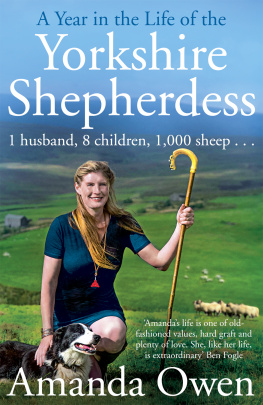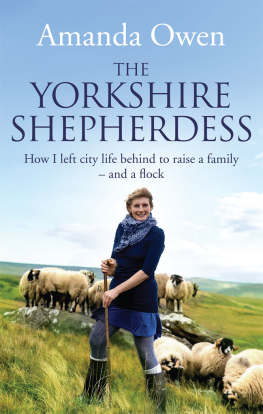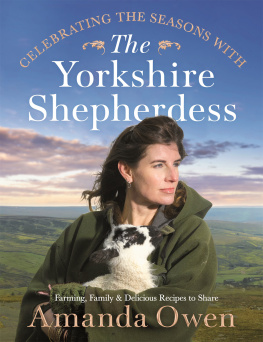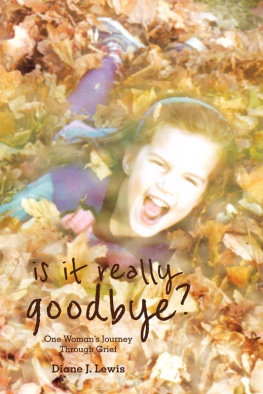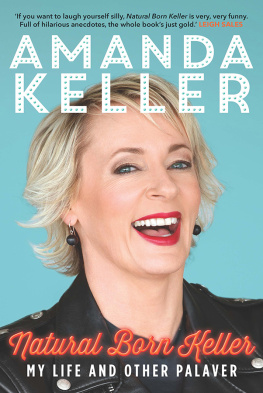A Year in the Life of the Yorkshire Shepherdess
AMANDA OWEN
SIDGWICK & JACKSON
To my family
Introduction
Thoo wont rein sa lang up theer, mi lass, said one old boy at the auction leaning over a gate whilst charging his pipe. Its as bleak an as godforsaken spot as thoo could wish for.
It is now more than twenty years since I first arrived at Ravenseat, and the beauty of the place comes fresh to me every time I climb the moor and look back across this broad sweep of Yorkshire countryside, with the ancient stone farmhouse and its outbuildings below me. It is tough terrain, bleak and unforgiving in winter. But it is grand and inspiring, a place where the seasons and unpredictable weather dictate to us every day of our lives, but where the rewards of life far exceed the difficulties. It is the place where my husband Clive and I rear sheep, cattle and, especially, children.
When I first arrived here, I was twenty-one. Id been working as a contract shepherdess, living in a tiny cottage in Cumbria with my sheepdogs, a handful of over-indulged pet sheep, a delinquent goat and a couple of horses. Id found my vocation: I had shunned the urban life that my childhood in Huddersfield had prepared me for and followed my dream to work in the great outdoors, with a dog at my feet and a stick in my hand, out on the hills, shepherding sheep.
When I met and fell in love with Clive I realized I wanted something more: a family. We didnt set out to create a supersize family, but somehow the openness and freedom of this wild, untamed place imprints itself, and filling the farmhouse with the noise and chaos of children seemed the right thing to do. Clive and I work alongside each other on our 2,000-acre farm, caring for our 900 sheep and thirty cattle. Our lifestyle encompasses the whole family: where we go, our children go, travelling for miles in my backpack when they are babies, learning to walk with their hands on the back of a gentle sheepdog, finding pleasure and contentment in the outdoor life that we all lead, whether it is skiing down the snowy fields in the depths of winter when we are snowed in and they cannot go to school, building makeshift dens for themselves in the hay when we crop the meadows in summer, swimming in the dark, peaty tarns, splashing in the icy waterfall behind the farmhouse, inventing games around our docile, long-suffering Shetland pony Little Joe, or riding our horses bareback for miles across the moors.
In my first book I told the story of my early years, how I was seduced by farming life, how I came to Ravenseat to collect a tup (a ram) for the farmer I was working for, and how that was the start of my lifelong love affair with Ravenseat, and the man who farms it, Clive Owen. I wrote about our growing family, and the trials and tribulations that go hand in hand with life on one of the bleakest, most remote hill farms in England.
Our lives are all about routine, but within these seemingly mundane tasks lie many variables: the unpredictability of the animals, the people, and of course the weather. No two days are the same. We relish the contrasts that this life and place bring, from the loneliness and desolation on the moor tops to the conviviality and warmth of evenings in the hayfields. It is said that in Yorkshire you can experience all four seasons within a day, and the same can be said of emotions. Spirits lifted, hopes dashed, from joy through to the depths of despair, life and death all there in their rawest form. This is what I love, revelling in the challenge of battling the storms, tramping the moors and rearing a family in this inhospitable place. The story of Ravenseat, and of the man, woman and eight children who live here, continues.
1
January
The north wind doth blow, and we shall have snow...
Even when the rest of the country is having the mildest of winters, up here it snows. Often it snows for days on end, the snow settling before stowering being whipped into a maelstrom by the fury of the wind sweeping from the open moors. Then it numbs our faces, stings our eyes and covers any tracks we make almost immediately. When the weather forecasts are reporting a dip in temperatures and wintry showers on high ground, we can be confident that we are in for trouble at Ravenseat.
The arrival of snow brings with it a blanket of whiteness that envelops everything, and the beauty of the changed landscape takes my breath away: even the familiar shapes of the buildings are distorted by the icy cloak, making it all appear so pure and clean. In my first winter at Ravenseat I soon realized why hill farms dont have letterboxes. The snow gets in everywhere, from the gap between the stable doors to the small barn windows. The incursion is not confined to animal quarters, and we stuff rags into keyholes and along sash windows to keep it out.
As long as the weather is calm and settled, the flocks remain on their heafs (the area of the moor which each sheep recognizes as its own terrain, and the only place they are truly happy). We study the forecasts assiduously, always erring on the side of caution, gathering up the sheep and bringing them down from the moor at the first mention of snowfall. We shepherd them down into the more sheltered ground nearer the farmhouse: then we can rest easy, knowing there is no risk of an overnight snowstorm burying them alive on the moor tops. In the worst of times, when even the lower fields are in danger of being happed up with drifting snow, we put the yows (yews) in the sheep pens where they are safe: their constant movement in the confined space means the snow is trampled under their hooves.
Its not hard moving sheep in winter: the rattle of a feed bag triggers a stampede towards the quad bike. The sheep are so addicted to their winter rations that they will follow a feed bag for miles in the hope of a meal of cake, which is a mixed ration of barley, corn, other cereals and vitamin concentrates. The dogs lollop along behind, keeping them in a tight bunch: it would be disastrous for any yow to be left behind in a snowstorm. Only when we have them where we want them do they get the cake, and a feeding frenzy ensues.
When the snow comes, it is not an even covering as the wind has a tendency to change direction, creating deep drifts against the walls the same places that the sheep naturally move to for shelter. Standing stock-still, heads down and fleeces encrusted with ice, they are sometimes completely covered, disappearing under the peaks, crests and swirls of the crisp white sea. Fortunately it is a rare occurrence for sheep to be buried in a snowdrift, but when it happens we use Bill, Clives dog, who can sniff out a sheep at twenty paces. We dig them out, but they are not grateful, often stubbornly digging their heels in and refusing to wade through the snow to safety.
One January Clive and I found some tup hoggs blown over in a ghyll next to a wall in the Peggy Breas, one of our fields. When their fleeces are clogged with the driving snow they become heavy, and are easily toppled by the wind. We could see heads, and in some cases legs, sticking out from the ridge of snow. They were all alive and well, but there was no gratitude and we puffed and blowed, sweating under our layers of clothing, as we dragged them by the horns one by one to the gate.
At least they ave andles, I said to Clive.
Every day at Ravenseat starts at 6 a.m., all year round. Clive pulls on his waterproof leggings and wellies and goes outside to start foddering the animals that are in the buildings in the farmyard. In the winter, when it is still dark at that time, it makes sense to feed and bed up around the yard before daylight, only setting off to check on the sheep when there is enough light to negotiate the precarious routes to the outlying flocks.
Next page
